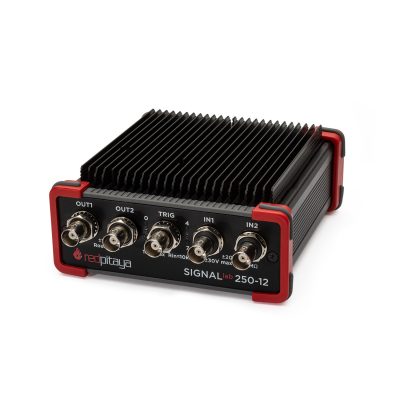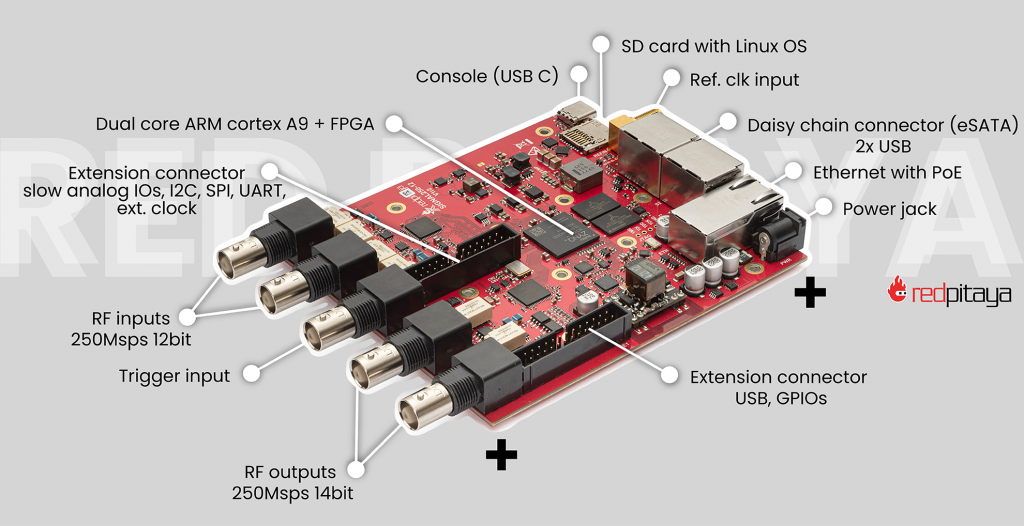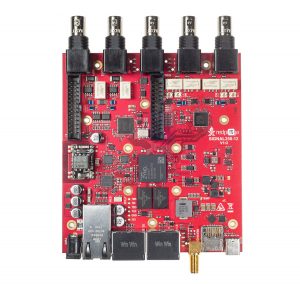SIGNALlab 250-12
SIGNALlab 250-12 is most sophisticated Red Pitaya product, built for more demanding industrial applications and research, where robustness and performance matter more than cost.
The device has full software control over the hardware and additional hardware features compared to other Red Pitaya products. Its larger Xilinx Zynq 7020 FPGA enables greater real-time processing capabilities plus a faster 250Msps sampling rate, and just like other Red Pitaya products it offers the benefits of remote access, with an online app user interface accessible through Ethernet or Wi-Fi.

Key features:
- Small form RF signal acquisition and generation platform
- Ethernet connectivity
- Xilinx SoC (CPU & FPGA)
- Two fast analog inputs and two outputs
- Possibility of integration into own system/product
- Open software source code available
- Power over Ethernet
- Works with Linux or Windows PC
- Free online apps (oscilloscope & signal generator, spectrum, Bode analyzer, logic analyzer, LCR meter*, streaming, network manager and calibration tool)
- Can be controlled remotely using LabVIEW, MATLAB, Python, or Scilab
- Can be programmed to meet custom needs
- An app marketplace with several free apps available
* Requires an extension module.

Technical specifications:
| Processor | Dual-Core ARM Cortex-A9 MPCore |
| FPGA | Xilinx Zynq 7020 |
| RAM | 1GB (8Gb) |
| System memory | Micro SD up to 32GB |
Ethernet | 1 Gbit |
USB | 2x USB 2.0 |
WI-FI | Using Wi-Fi dongle |
|
Channels |
2 |
|
Sample rate |
250MS/s |
|
ADC resolution |
12bit |
|
Full scale voltage range** |
+-1V / +-20V |
|
Input coupling** |
AC/DC |
|
Bandwidth |
DC-60MHz |
|
Input impedance |
1Mohm |
|
Channels |
2 |
|
Sample rate |
250MS/s |
|
ADC resolution |
14 bit |
|
Full scale voltage range** |
+-1V / +-5V (into 50 ohm load) |
|
Load impedance |
50 ohm |
|
Shortcut protection |
Yes |
|
Typical rising/falling time |
10V / 17ns |
|
Bandwidth |
DC – 60MHz |
|
Digital IOs |
16 |
|
Analog inputs |
4 channels 0-3.5V 12bit |
|
Analog outputs |
4 channels 0-1.8V 12bit |
|
Communication interfaces |
I2C, UART, SPI, USB |
|
Available voltages |
+5V, +3.3V, -4V |
Trigger input | through BNC connector |
Daisy chain connection | over SATA connection |
Ref. clock input | through BNC connector |
**software selectable
Applications:
- Automated testing
- Remote measurement
- Acoustic signal processing
- Communications
- Remote scope meters
- Portable test and measurement tool
- Remote system debugging
- OEM DAQ device
Red Pitaya is used in various fields
Red Pitaya’s SIGNALlab 250-12 is perfect for advanced industrial users and thus most used in industrial segments such as automotive, telecommunications, aerospace, defence and medical. Nevertheless, it can still be used in other fields like research or academia where there’s a need for bigger speed of FPGA.
Explore SIGNALlab 250-12 kits


Additional features available
| Features | Standard kit |
| Oscilloscope & signal generator | Included |
| Spectrum analyzer | Included |
| Logic analyzer Probes | $38.50Read more |
| Logic analyzer Extension Module | $77.00Add to cart |
| Bode analyzer | Included |
| LCR meter | Included |
| Streaming | Included |
| SDR | Not available |
| VNA | Not available |
| SCPI server (MATLAB, LabVIEW, Python) | Included |
| Jupyter notebook (Python) | Not available |
| Aluminium case | Included |
Our customers' testimonials
I have had the chance to have a Red Pitaya from the initial release. The device is my “go-to” desktop testing tool. Its capabilities far exceed its size. The best part is that the community is expanding as are the hardware and software options. The Red Pitaya is truly blossoming. I look forward to its future growth.
Research Instruments Corporation incorporates a Red Pitaya into the core of its X-ray Plasma Sources. The Red Pitaya allows us to eliminate the need for a separate control computer and monitor the X-ray output in a reliable, compact and cost effective-manner. Thanks to their size, capability and reliability, Red Pitayas are the brain behind our X-ray sources going forward.
"We found Red Pitaya to be the ideal tool for designing our next generation electrochemical workstations. After trying several design options, we are now convinced about the value addition it brings to our Potentiostats for complex voltammetry methods like electrochemical impedance spectroscopy in a very simplistic way."